MLB awards: NL Rookie of the Year top seven contenders

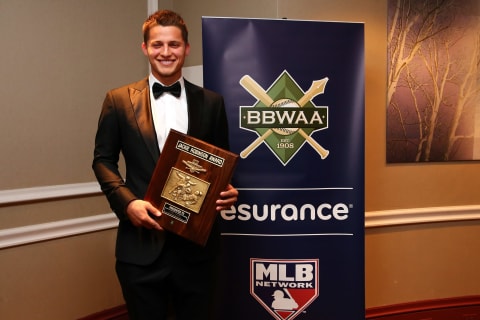
The NL ROY race has two big-name contenders and five other rookies having impressive seasons as MLB awards voting starts to take place.
It’s been quite some time since the NL has seen a close Rookie of the Year vote in MLB awards voting. The last three years have resulted in unanimous winners, from Kris Bryant in 2015 to Corey Seager in 2016 to Cody Bellinger in 2017. All three players received all 30 first place votes in their respective seasons.
Not only did Bryant, Seager and Bellinger sweep the NL Rookie of the Year MLB awards votes, they also picked up NL MVP votes in their first seasons in the big leagues. They weren’t just good for rookies; they were good even when compared to the veterans in the league. It’s been an impressive crop of NL rookies the last three seasons.
In 2014, Jacob deGrom received 26 of 30 first place votes, with Billy Hamilton picking up the other four. The year before that, Jose Fernandez snagged 26 of 30 first place votes and Yasiel Puig earned the other four. That makes it five straight seasons without a close NL Rookie of the Year race.
This year will be different. This year may resemble the 2012 season, when Bryce Harper had 16 first place votes and Wade Miley had 12. This year has two high-profile rookies and another coming on strong who may very well garner all 30 votes among them, along with four other players who are off to good starts to their major league careers.
Of course, we must remember that we’re just finishing the first week or so of September. There are big moments yet to happen and stories still to be written. Four of the rookies I’ve identified as the top contenders for the NL Rookie of the Year Award are on potential playoff teams. The other three are out of the running, but shouldn’t be dismissed simply because their teams haven’t been successful. Let’s take a look at the top seven contenders for the NL Rookie of the Year Award.
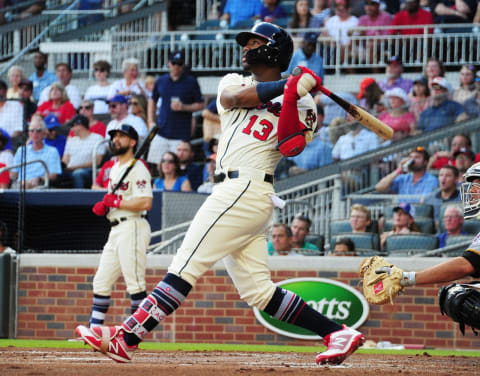
OF Ronald Acuña, Jr. Atlanta Braves
Fangraphs WAR: 3.3
Baseball-Reference WAR: 4.0
Wins Above Average: 2.8
With roughly three weeks left in the season, Ronald Acuna, Jr. of the Atlanta Braves is the leading contender for the NL Rookie of the Year Award. A few weeks ago, he was in a tight battle with Juan Soto, but he just keeps on hitting and Soto has slowed down a bit. Acuña has an impressive .293/.367/.581 batting line, with 25 home runs and 67 runs scored in just 92 games played. His 150 wRC+ would be right there with Matt Carpenter and Christian Yelich at the very top of the NL if he had enough plate appearances to qualify for the batting title.
The 20-year-old outfielder doesn’t have enough plate appearances to qualify for the batting title in part because the Atlanta Braves played some roster shenanigans early in the season. They left him in Triple-A until April 25 even after he hit .432/.519/.727 in spring training. He also missed about a month in June with a mild ACL strain.
Acuña has also shown an impressive ability to get the party started early, with eight leadoff home runs. That’s a franchise record and has him one short of the MLB rookie record set by Chris Young in 2007. The single-season record for leadoff home runs is 13, by Alfonso Soriano in 2003.
Despite the late start and the missed time due to injury, Acuña is projected to finish with between 3.5 and 4.5 WAR in about two-thirds of a season. He’s been everything the Braves hoped he would be and has been a big part of the Braves’ success this year. They currently lead the NL East by 4.5 games over the Philadelphia Phillies and 8 games over the Washington Nationals. Their +96 run-differential is third-best in the National League.
Should Acuña win the Rookie of the Year Award, he’ll become the eighth Braves player to take the honor. The first two Braves winners won the award when the team was still located in Boston. Alvin Dark took home the trophy in 1948 and Sam Jethroe won it in 1950.
Since the team moved to Atlanta, they’ve had five NL Rookie of the Year winners. Sluggers Earl Williams (33 HR) and Bob Horner (23 HR) were acknowledged as the league’s best rookies in 1971 and 1978, respectively. In 1990, David Justice won it. Ten years later, it was Rafael Furcal’s turn and Craig Kimbrel brought the trophy home in 2011.
Should Acuña win the award this season, the Braves could join the Yankees with eight winners, second only to the Dodgers in MLB awards history. Of course, the Yankees could make it nine this year if Miguel Andujar or Gleyber Torres win the AL Rookie of the Year Award.
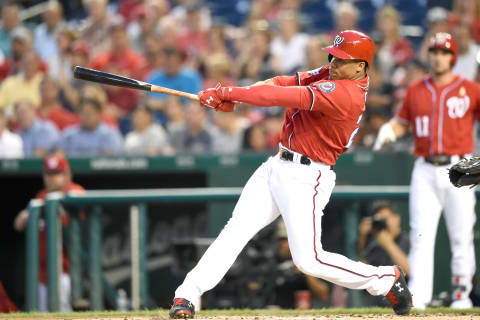
OF Juan Soto, Washington Nationals
Fangraphs WAR: 3.1
Baseball-Reference WAR: 2.3
Wins Above Average: 1.0
Another media favorite for the NL Rookie of the Year Award is the Washington Nationals’ Juan Soto. Incredibly, at just 19 years old, Soto is even younger than Ronald Acuña. The Nationals outfielder crushed three levels of minor league baseball before making his major league debut with Washington on May 15. He’s been nearly as good as Acuña on offense, with a 146 wRC+, but his defense drops him below Acuña in Fangraphs WAR and Baseball-Reference WAR.
One measure in which Soto tops Acuña is Win Probability Added (WPA), which “captures the change in Win Expectancy from one plate appearance to the next” (Fangraphs definition). In high leverage situations, Soto has hit .318/.458/.545, which is much better than Acuña’s .250/.317/.446 in similar circumstances. This gives Soto a 2.4 to 1.2 advantage in WPA, per Fangraphs. In a close awards race, WPA could be used as a deciding factor.
One of the keys to Soto’s success has been an impressive control of the strike zone. Acuña has struck out 25.1 percent of a time and walked 9.4 percent of the time, which isn’t far off the averages in the National League (22.4 percent strikeout rate, 8.6 percent walk rate). Soto has struck out less often than the average hitter and his 16.7 percent walk rate is third in the NL for batters with 300 or more plate appearances. The two players ahead of him are Joey Votto and Bryce Harper.
Should Soto win the NL ROY, he would join current teammate Bryce Harper as the second Washington Nationals player to win the award. Harper won it in 2012 when he narrowly defeated Arizona pitcher Wade Miley. Harper’s victory over Miley in 2012 is the closest NL ROY race in the last six years.
If you consider the Montreal Expos as part of the Washington Nationals franchise, as MLB does, then two other players can be included with Harper. In 1970, Carl Morton was 18-11 with a 3.60 ERA in 284.7 innings and bested Bernie Carbo in NL ROY MLB awards voting. In 1977, Hall of Fame outfielder Andre Dawson hit .282/.326/.474 and very narrowly defeated Mets outfielder Steven Henderson in the NL Rookie of the Year race.
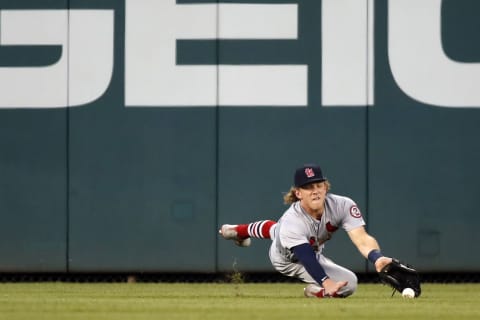
OF Harrison Bader, St. Louis Cardinals
Fangraphs WAR: 3.4
Baseball-Reference WAR: 3.9
Wins Above Average: 2.8
If the NL Rookie of the Year Award were based purely on advanced statistics, it would be hard to argue that Harrison Bader isn’t right there with Acuńa. Bader leads NL rookies in Fangraphs WAR by 0.1 over Acuńa and trails Acuńa by 0.1 in Baseball-Reference WAR. They are tied in Wins Above Average. He’s been an important part of a St. Louis Cardinals team that currently holds the second wild card spot in the National League.
Despite his strong rookie season, Bader hasn’t received the recognition that Acuña and Soto have. The two young outfielders have impressed fans with their excellent hitting. Acuña has 25 homers and 67 runs scored. Soto has a .416 OBP, 16 HR, and 56 RBI. Bader has just 10 home runs, 52 runs scored, and 30 RBI.
Where Bader makes up ground is his baserunning and his incredible defense. On the bases, he leads all rookies with 14 steals and he’s only been caught three times. In the field, no outfielder in the NL comes close to Bader in UZR/150 (minimum 700 defensive innings). His 25.3 mark is nearly double the next-closest outfielder, Lorenzo Cain (12.7).
Bader doesn’t have the power of Acuña or the plate discipline of Soto, but his all-around game has been right there with both guys. Because he’s five years older than Soto and four years older than Acuña, Bader doesn’t have the high ceiling potential they have, but at this point of this season, he would be a deserving Rookie of the Year.
Should he win the award, he would become the seventh St. Louis Cardinal rookie to take home the trophy in MLB awards. The franchise had back-to-back winners in 1954 and 1955 when Wally Moon and Bill Virdon were the NL’s best newcomers. In 1974, outfielder Bake McBride won the prize. The Cardinals again had back-to-back winners in 1985 and 1986 when Vince Coleman and Todd Worrell got the nod. Their most-recent winner was Albert Pujols in 2001.
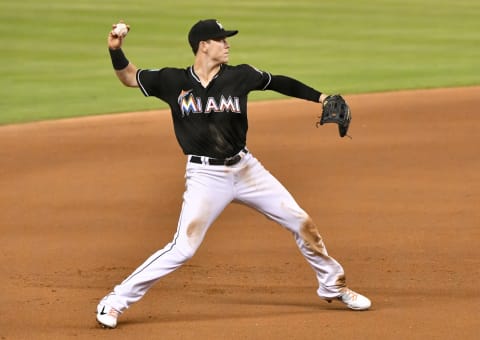
3B/OF Brian Anderson, Miami Marlins
Fangraphs WAR: 2.9
Baseball-Reference WAR: 3.4
Wins Above Average: 1.6
Rookie outfielder/third baseman Brian Anderson has been one of the bright spots during a rebuilding year in Miami. He’s been a fixture in the lineup, playing in 140 of their 144 games. He’s hitting .270/.356/.394, leads the team with 77 runs scored and is second on the team with 58 RBI. Anderson has joined catcher J.T. Realmuto and second baseman Starlin Castro as the only three above-average position players on the team.
As a hitter, when league and ballpark effects are considered, Anderson has been nearly the equal of Harrison Bader. His 111 wRC+ means he’s been 11 percent better than league average at the dish. That puts him significantly below Acuña and Soto, who are at 150 and 146, respectively, but still above average among all players.
Anderson, like Bader, makes up some ground on Acuña and Soto on defense. He’s played well in right field and third base this season. In right field, he’s there at the top of the list with Jason Heyward and Carlos Gonzalez in UZR/150. He’s more middle-of-the-pack at third base, but still rates above average at the position.
One area in which Anderson really sets himself apart is Win Probability Added because he’s been incredible when it counts the most. In high leverage situations, he’s hit .415/.470/.602. His 2.8 WPA is a win better than Juan Soto (2.4 WPA) and more than two wins better than Ronald Acuña (1.2 WPA) and Harrison Bader (0.7 WPA).
Because his value has come on defense and clutch hitting, rather than the more visible offensive numbers that media members are likely to consider, it wouldn’t be surprising to see Anderson do poorly in MLB awards voting for the NL ROY. Playing for the Marlins doesn’t help him either, although the team has four previous NL ROY winners—Dontrelle Willis in 2003, Hanley Ramírez in 2006, Chris Coghlan in 2009 and José Fernández in 2013).
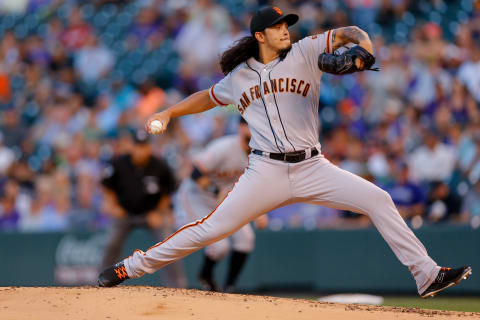
SP Dereck Rodriguez, San Francisco Giants
Fangraphs WAR: 1.8
Baseball-Reference WAR: 3.0
Wins Above Average: 2.2
The San Francisco Giants traded for veterans Evan Longoria and Andrew McCutchen prior to this season in the hopes they could put last year’s awful performance behind them. They thought they could compete for a playoff spot, maybe even win the NL West.
Instead, the veterans disappointed and the pitching staff went up in smoke. Instead of Madison Bumgarner, Johnny Cueto and Jeff Samardzija leading the staff, the three starters most used by the Giants this year are Derek Holland, Andrew Suarez and Chris Stratton. Then comes Bumgarner, followed by Dereck Rodriguez, son of Hall of Fame catcher Pudge Rodriguez.
Of the 10 starting pitchers used by the Giants so far, Rodriguez has been the best. He’s started 15 of his 17 games and has a 2.41 ERA in 97 innings. Of course, he’s not reallya true talent 2.41 ERA guy because his FIP is 3.37 and his xFIP is 4.16. The 2.41 ERA reflects the earned runs he’s actually allowed, though, so he should get some credit for it.
Rodriguez also fares well in Wins Above Average and Win Probability Added. I wouldn’t expect him to compete with the four hitters mentioned previously in NL ROY voting, but he’s deserving of a closer look. At the very least, he’s in the conversation with Walker Buehler and Jack Flaherty as the NL’s best rookie pitcher.
The Giants have an impressive history of Rookie of the Year MLB awards winners that goes all the way back to Willie Mays in 1951. Seven years after Mays earned the honor, Orlando Cepeda and Willie McCovey won the award in 1958 and 1959, respectively. Fourteen more years passed before Gary Matthews won it in 1973 and John Montefusco did the same two years later.
Then there was a long dry spell for the rest of the 1970s and all of the 1980s and 1990s. That drought ended when Buster Posey arrived in 2010 and became the Giants six NL ROY winner. Unless he does something spectacular, Dereck Rodriguez won’t be the next Giants NL ROY winner, but he’s off to a good start in his career nonetheless.
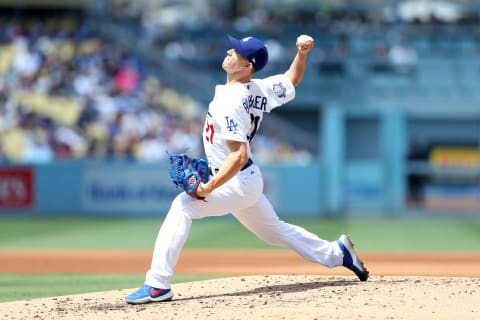
SP Walker Buehler, Los Angeles Dodgers
Fangraphs WAR: 2.3
Baseball-Reference WAR: 2.5
Wins Above Average: 1.6
Walker Buehler is the top rookie pitcher in the National League based on Fangraphs WAR, which uses FIP instead of ERA. Buehler’s FIP components—strikeouts, walks and home runs allowed—are better than the other two rookie pitchers on this list, Dereck Rodriguez and Jack Flaherty. Strikeouts, walks and home runs allowed are considered to be the three things a pitcher has the most control over.
Buehler has a 3.26 FIP compared to 3.37 for Rodriguez and 3.77 for Flaherty. The pitcher’s actual ERAs are 3.09 for Buehler, 2.41 for Rodriguez, and 2.92 for Flaherty. This is why Rodriguez has the highest Baseball-Reference WAR and Buehler the lowest. Rodriguez also leads all three pitchers in Wins Above Average and Win Probability Added.
When it comes to pure heat, Buehler is the top dog here. He has the highest average fastball velocity of any NL rookie starting pitcher. His heater sits at 96.0 mph. Flaherty clocks in at 92.6 mph and Rodriguez is at 91.5 mph.
The Dodgers have used 11 starting pitchers this year, including six with at least 100 innings pitched. Of those six, Buehler has the third-best ERA. The two with better ERAs are Ross Stripling and longtime ace Clayton Kershaw. The team sits a half-game behind the Rockies in the NL West and a single game behind the Cardinals for the second wild card spot. Buehler has been one of the reasons they’re as close to a playoff spot as they are.
Barring an incredible final stretch of starts, Buehler is unlikely to win the NL ROY Award. He’s in the running for best rookie pitcher in the league, but the four hitters mentioned here should get more NL ROY votes. Still, it’s been an impressive debut for the pitcher who was ranked 13th on the Baseball America Top-100 prior to this season.
The Dodgers, famously, have had more Rookie of the Year Award winners than any other team and it’s not very close. From the first ever ROY, Jackie Robinson in 1947, to last year’s winner, Cody Bellinger, the Dodgers have 18 players who have been named top rookie in the National League in MLB awards.
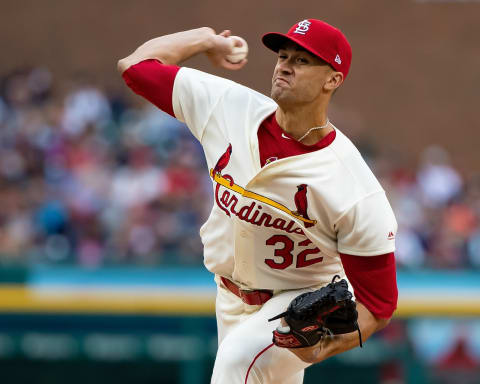
SP Jack Flaherty, St. Louis Cardinals
Fangraphs WAR: 2.2
Baseball-Reference WAR: 2.9
Wins Above Average: 1.8
Jack Flaherty was a consensus top-100 prospect prior to the season, but he wasn’t expected to shoulder as much of the workload as he has for the Cardinals this year. He’s third on the team in starts and innings pitched, behind Miles Mikolas and Luke Weaver, and has the best ERA of the three.
One of the surprising things about Flaherty’s season is his impressive strikeout rate. After regularly punching out 22 to 25 percent of the batters he faced in the minor leagues from 2015 to 2017, Flaherty has bumped it up to around 30 percent this year in Triple-A and the major leagues. He has the fourth-best strikeout rate among all NL pitchers with more than 120 innings pitched in 2018. The three NL pitchers with better strikeout rates are Max Scherzer, Jacob deGrom and Patrick Corbin.
With Flaherty’s help, the Cardinals currently hold the second wild card spot by a game over the Dodgers and three games over the Diamondbacks. Flaherty will likely have three or four more starts down the stretch to help get the Cards to the playoffs. All of those starts are slated to be against playoff contending team.
If he can pitch well in each of them, it should help his narrative in NL ROY voting, although he’s still unlikely to beat out Ronald Acuńa or Juan Soto and he’s contending with teammate Harrison Bader for the honor. The Cardinals have six Rookie of the Years in their history. Bader is more likely than Flaherty to be number seven.
dark. Next. AL Rookie of the Year contenders
While there are two guys that should dominate the MLB awards voting for NL Rookie of the Year, but there are a host of guys who could sneak into things, and they’ve all had great years! Who do you think should be the guy? Comment below!